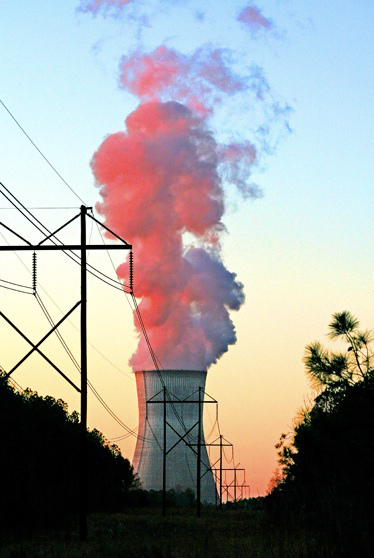|
7.10
Avoiding a Meltdown
It’s an unfortunate fact that most
flash units are made of plastic. Another unfortunate fact is that
plastic melts when it gets hot. In intense shooting situations
it’s possible to overheat your flash head and possibly melt one or more
parts on the unit. Very slight melting may only result in
decreased light transmission through the bulb cover. Often,
however, a meltdown is disastrous.

Fig. 7.10.1 :
Although a flash meltdown isn't quite as bad
as a nuclear meltdown, it can still be disastrous, especially
if you're traveling many miles from home and don't have a
backup unit handy.
The problem is that the gas inside the flash’s bulb heats up during
each flash pulse to an astronomically high temperature, and if
sufficient
time isn’t allowed between shots for the heat from the bulb to
dissipate, that heat can damage the unit. The problem is worse
for longer flash durations (i.e. higher “flash power”). Many
flash manufacturers recommend that you don’t take a certain number of
full-power shots within a certain time interval—say, for example, no
more than 20 full-power shots in a minute, or perhaps within 5
minutes. The exact numbers differ between units, so be sure to
read your unit’s user manual. Note that the limits can apply, to
a lesser extent, to even shorter flash pulses, so that, e.g., a certain
number of half-power shots within some number of minutes or seconds may
also cause a meltdown.
It’s important to realize that by “full power” the
manufacturers mean that the flash’s “power” (duration) is at its
maximum, as defined by the highest setting in manual flash mode.
In the autoexposure modes, with TTL flash metering, you generally won’t
be able to set the actual “power” level of the flash itself;
instead,
you’ll be dialing in a flash
exposure compensation (FEC)
level, which works essentially like the traditional exposure
compensation mechanism for non-flash photos. The FEC only allows
you to modify the flash
setting preferred by the camera, by adding or subtracting stops of
light. Thus, it’s generally not possible to know, when you’re
shooting, whether the flash level is at full power when using TTL
flash. If the scene you’re shooting is extremely dim, even a
negative FEC setting could, conceivably, result in the camera using the
flash’s maximum power setting, so that too many consecutive shots could
potentially result in a meltdown.
For this reason, I recommend using manual flash mode
only, and sticking to settings not much greater than 1/4 power.
For challenging lighting situations you can of course turn up the power
to 1/2 or 3/4 or even full power, but in these cases you just need to
be careful not to take too many high-power shots within a short period
of time, as indicated by the specs for your particular make and model
of flash unit. Note that operating the flash unit in manual flash mode doesn’t mean
operating the camera in
manual mode. Manual
flash mode can be used in any of the camera’s exposure modes, including
the autoexposure modes. The advantage is that in manual flash
mode you can set the flash’s power level (duration) explicitly, rather
than indirectly via an FEC bias, and this gives you a better chance to
avoid a meltdown. The disadvantage is that as the autoexposure
system modifies its exposure parameters it won’t be able to modify the
flash output, so your flash ratio
(section 7.2) may change unless you (manually)
change the flash
setting accordingly. For this reason, it can be simpler to just
operate both the camera and flash in manual mode; this is what I do.
There are a few other things you can do to avoid a
meltdown. Obviously, if you’re taking lots of high-powered flash
shots, it’s good to check the flash head to see if it feels hot to the
touch. If so, then you may need to slow down your rate of
shooting. Also, if you have two flash heads (one for your flight
rig and one for your tripod-mounted rig), you can occasionally swap
them during
intense shooting sessions if you’re using one camera more than the
other.
Finally, if you fear that you may be headed toward a
meltdown, consider changing your exposure parameters so as to depend
less on flash and more on ambient light. Alternatively, you might
consider using a slower shutter speed (in the case of high-speed sync)
or a larger aperture (smaller f-number)
so that you can turn down the
flash “power” while still capturing the same
amount of flash-emitted
light on your sensor. Note also that some newer flash models
(such as Canon's 580EX II) incorporate an auto-shutoff mechanism that
can effectively prevent a
meltdown by disabling the flash if it reaches a certain
temperature. In some cases, the added cost of buying such a model
versus a cheaper model can pay for itself by preventing a flash-induced
meltdown.
|
|
|
